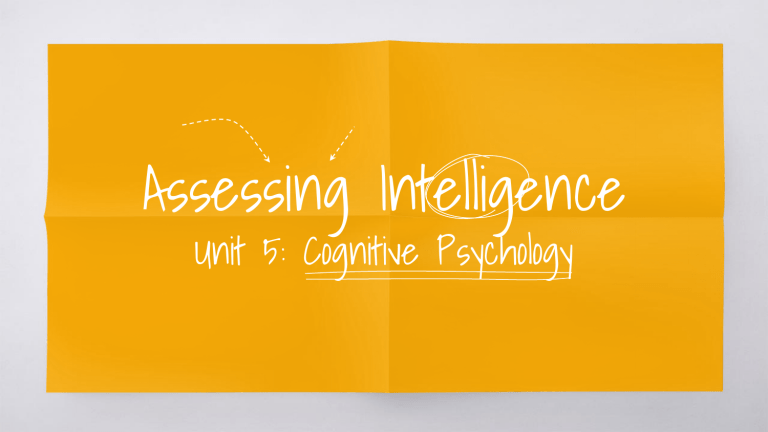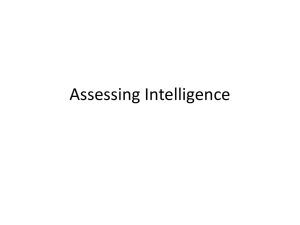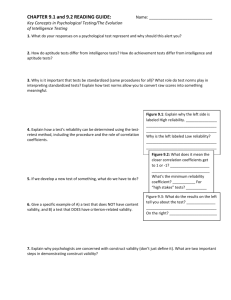
Assessing Intelligence Unit 5: Cognitive Psychology Learning Targets 5.O Identify the contributions of key researchers in intelligence research and testing. 5.O.1 Contributions of Alfred Binet, key researcher in intelligence 5.O.2 Contributions of Francis Galton, key researcher in intelligence 5.O.6 Contributions of Lewis Terman, key researcher in intelligence 5.O.7 Contributions of David Wechsler, key researcher in intelligence 5.P Explain how psychologists design tests, including standardization strategies and other techniques to establish reliability and validity. 5.Q Interpret the meaning of scores in terms of the normal curve. 5.R Describe relevant labels related to intelligence testing. 5.R.1 Gifted 5.R.2 Intellectual disability 2 Assessing Intelligence Psychologists define intelligence testing as a method for assessing an individual’s mental aptitudes and comparing them with others using numerical scores. 3 Alfred Binet … and his colleague Théodore Simon developed the first standardized intelligence test…they were commissioned by the French government to design a “test” to identify French children who would have problems in regular classes 4 Binet’s impact Set out to find a child’s mental age, or the average age of individuals who achieve a particular level of performance Binet did not create the test to LABEL children…he actually warned that if the information were misused it would do just this…instead he wanted only to find a way to help improve the educational experience of French children 5 Lewis Terman (in the US) Terman adapted/revised Binet’s test for American school children and named the test the Stanford-Binet IQ Test. (he worked at Stanford) ▧ 6 A form of the StanfordBinet is still in use today… The Stanford-Binet Test Today…the Stanford-Binet is given orally and varies in nature according to the person taking the test ▧ Children – given figures to copy or everyday problems to solve ▧ Adults – asked to solve analogies, explain proverbs and describe similarities that underlie sets of words ▧ The examiner begins by finding a mental age at which the person can answer all questions…move on to more difficult problems…when mental age is reached at which no items can be answered, test is over 7 William Stern IQ = chronological age = 100 Mental age 8 ▧ Introduced the formula of Intelligence Quotient (IQ) ▧ IQ is no longer computed this way… David Wechsler … developed the Wechsler Adult Intelligence Scale (WAIS) and later the Wechsler Intelligence Scale for Children (WISC), an intelligence test for preschoolers – they are the most widely used IQ tests today. 9 WAIS WAIS measures overall intelligence – consists of 2 parts, verbal and performance ▧ ▧ Verbal – vocab definitions and comprehension Performance – timed assembly of small objects and arranged pictures in logical order Normally verbal and performance are within close range, yet separate scores can give a more precise picture of a person’s specific abilities 10 Types of Tests Achievement Tests Aptitude Tests are intended to reflect what you have already learned – current level of knowledge are intended to predict your ability to learn a new skill – how well you could do ▧ Examples?? ▧ Examples??? ▧ AP Psych Exam ▧ ACT/SAT 11 Principles of Test Construction For a psychological test to be acceptable it must fulfill three criteria: 1. Standardization 2. Reliability 3. Validity 12 Standardization Test items piloted on a similar population of people and “norms” have been established ▧ Norms are developed by calculating the average score achieved by a particular group and then each person’s score can be compared to see how it differs from people who have taken the test in the past. 13 For example… The AP Psychology exam you’ll take in May was given to a sample of freshmen in college within the last few years to “normalize” the test (to find the norms). ▧ This group that’s given the test to find the norms is called the standardization sample ▧ The average (one of the norms) from this group is what this year’s scores will be compared to 14 Standardization periodically tests are re-standardized – given to a random, representative sample to reset/check the established norms (including intelligence tests whose “normal” score is 100). 15 Something to ponder…. Let’s say I took the AP Psychology Exam back in 2005 and got a 4. ▧ Let’s say you get a 4 on this year’s test. What does the Flynn effect say about the difference in our scores? ▧ So then why are our scores both a 4? 16 Normal Curve Standardized tests establish a normal distribution of scores on a tested population — a bell-shaped pattern called the normal curve. Numbers to remember… Disability Standard Deviation = 15 70 100 17 130 Gifted Francis Galton … argued that intelligence is quantifiable and normally distributed, believing we could assign a score for intelligence, which then determined who fell below the average range and who fell above it. 18 Reliability A test is reliable when it yields consistent results. To establish reliability researchers establish different procedures: You know a tape measure is reliable because every • Split-half Reliability: the test into two equal halves timeDividing you measure your and assessing how consistent theyou scores height, it shows as are. • Reliability using different tests: Using different forms of the same height. the test to measure consistency between them. • Test-Retest Reliability: Using the same test on two occasions to measure consistency. 19 Validity Reliability of a test does not insure validity. Validity of a test refers to the grader test is supposed A testing example – Awhat second is taking to When youor want to predict. a math test.measure All the problems are word measure your weight you problems with higher vocabulary and he don’t use a the rulerextent (because • Content Validity: Refers test measures a struggles to show to that he reallyaknows math thattrait. would not be a particular behavior because of it. or Is that test measuring ONLY his VALID assessment of of a test in • Predictive Validity: Refers tovalid the function math? No, it’s not a measurement of your weight). predicting a particular or trait. math skills duebehavior to high-level vocabulary. A test can be reliable but not valid. Meaning it yields consistent results, but doesn’t measure what it says it’s measuring. 20 Extremes of Intelligence Unit 5: Cognitive Psychology Extremes of Intelligence A valid intelligence test divides two groups of people into two extremes. The intellectually disabled (IQ 70) and the intellectually gifted (IQ 130) are significantly different. Numbers to remember… Disability Standard Deviation = 15 70 100 22 130 Gifted Intellectual Disability Having significantly below-average intellectual functioning and limitations in at least two areas of adaptive functioning ▧ ▧ ▧ ▧ ▧ communication skills self-care ability to live independently social skills community involvement 23 ▧ ▧ ▧ ▧ self direction health and safety academics leisure and work Intellectual Disability Causes can be varying factors, but can include ▧ Genetics (down syndrome) ▧ Environmental (FAS, SBS) ▧ Deprivation/neglect ▧ No apparent/known cause There is no cure, but some preventative measures can be take for certain causes of intellectual disability… 24 Intellectual Disability ▧ test performed on newborns tests for hidden genetic disorder called PKU…if detected early, the intellectual disability associated with PKU can be prevented by a special diet ▧ more generally…genetic counseling, pregnancy care services and education of new parents are other preventative strategies 25 Intellectual Disability Levels Mild (50-70 IQ) 85% of all MR – academic abilities at approx. 6th grade level…can learn to live on own and hold a job Moderate (3549 IQ) Severe (20-34 IQ) Profound (below 20 IQ) academic abilities approx. 2nd grade level – can be trained in self-care and acquire some reading/writing skills, yet need some supervision mental capacity of approx. a 5year-old – learn to talk in most cases and perform simple tasks, yet need close supervision mental age less than 3 – very limited communication and require constant supervision… numerous physical disabilities common. 26 Intellectual Gifted … have IQ scores above 130-135. Most extensive research on “giftedness” was done by Terman...resulting data much of what we know about subject ▧ ▧ studied 1528 students near top of IQ range into adulthood found that gifted children excelled in school, had overall good health, were generally happy (newer research suggests that highly gifted children may be susceptible to certain physical or psychological disorders) ▧ most continued on a path of success, yet most led ordinary, undistinguished lives 27 Credits Special thanks to all the people who made and released these awesome resources for free: ▧ Presentation template by SlidesCarnival ▧ Photographs by Unsplash ▧ Backgrounds by Pixeden 28 Presentation design This presentations uses the following typographies and colors: ▧ Titles: Shadows into light ▧ Body copy: Varela round You can download the fonts on these pages: https://www.dafont.com/shadows-into-light.font https://www.fontsquirrel.com/fonts/varela-round ▧ ▧ ▧ ▧ ▧ ▧ Dark grey #505670 Light grey #979cb8 Blue #01abcf Yellow #f9ac08 Magenta #ea3a68 Green #aacf20 You don’t need to keep this slide in your presentation. It’s only here to serve you as a design guide if you need to create new slides or download the fonts to edit the presentation in PowerPoint® 29 SlidesCarnival icons are editable shapes. This means that you can: ● Resize them without losing quality. ● Change fill color and opacity. Isn’t that nice? :) Examples: 30 😉 Now you can use any emoji as an icon! And of course it resizes without losing quality and you can change the color. How? Follow Google instructions https://twitter.com/googledocs/status/730087240156643328 ✋👆👉👍👤👦👧👨👩👪💃🏃💑❤😂 😉😋😒😭👶😸🐟🍒🍔💣📌📖🔨🎃🎈 🎨🏈🏰🌏🔌🔑 and many more... 31



